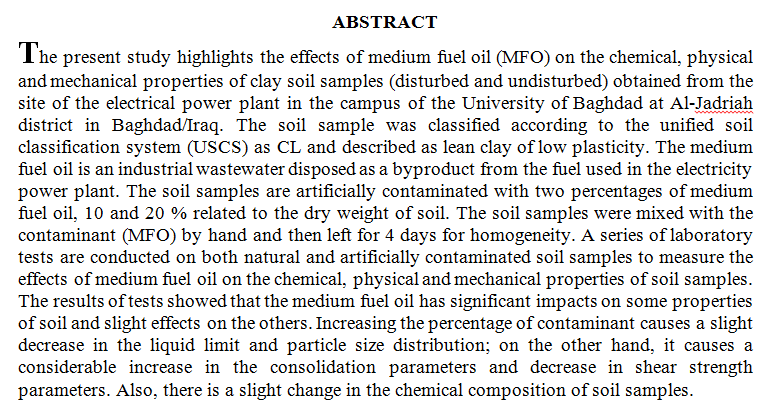
The assessment of data quality from different sources can be considered as a key challenge in supporting effective geospatial data integration and promoting collaboration in mapping projects. This paper presents a methodology for assessing positional and shape quality for authoritative large-scale data, such as Ordnance Survey (OS) UK data and General Directorate for Survey (GDS) Iraq data, and Volunteered Geographic Information (VGI), such as OpenStreetMap (OSM) data, with the intention of assessing possible integration. It is based on the measurement of discrepancies among the datasets, addressing positional accuracy and shape fidelity, using standard procedures and also directional statistics. Line feature comparison has been und
... Show More (28)
(28)
 (26)
(26)
To learn how the manner of preparation influences film development, this study examined film expansion under a variety of deposition settings. To learn about the membrane’s properties and to ascertain the optimal pretreatment conditions, which are represented by ambient temperature and pressure, Laser pressure of 2.5[Formula: see text]m bar, the laser energy density of 500[Formula: see text]mJ, distortion ratio ([Formula: see text]) as a function of laser pulse count, all achieved with the double-frequency Nd: YAG laser operating in quality-factor mode at 1064[Formula: see text]nm. MgxZn[Formula: see text] films of thickness [Formula: see text][Formula: see text]nm were deposited on glass substrates at pulse
... Show More (1)
(1)
 (1)
(1)
 (18)
(18)
 (21)
(21)
Bendable concrete, also known as Engineered Cementitious Composite (ECC) is a type of ultra-ductile cementitious composites reinforced with fibres to control the width of cracks. It has the ability to enhance concrete flexibility by withstanding strains of 3% and higher. The properties of bendable concrete mixes (compressive strength, flexural strength, and drying shrinkage) are here assessed after the incorporation of supplementary cementitious materials, silica fume, polymer fibres, and the use of ordinary Portland cement (O.P.C) and Portland limestone cement (IL). Mixes with Portland limestone cement show lower drying shrinkage and lower compressive and flexural strength than mixes with ordinary Portland cement, due to the ratio o
... Show MoreConventional concretes are almost unbending, and even a small amount of strain potential leaves them brittle. This lack of bendability is a major source of strain loss, and it has been the main goal behind the development of bendable concrete, often known with engineered ce ment composites, or ECC. This form of concrete has a lot more flexibility than regular concrete. Micromechanical polymer fibers are used to strengthen ECC. In most cases, ECC uses a 2% amount of thin, separated fibers. As a result, bendable concrete deforms but unlike traditional concrete, it does not crack. This study aims to include this kind of concrete, bendable concrete, which can be used to solve concrete problems. Karasta (CK) and Tasluja (CT) Portland Lime
... Show MoreIn this study, two active galaxies (NGC4725, NGC4639) have been chosen to study their morphological and photometric properties, by using the IRAF ISOPHOTE ELLIPS task with griz-filters. Observations are obtained from the Sloan Digital Sky Survey (SDSS) which reaches now to the DATA Release (DR14). The data reduction of all images (bias and flat field) has been done by SDSS Pipeline. The surface photometric investigation was performed like the magnitude. Together with isophotal contour maps, surface brightness profiles and a bulge/disk decomposition of the images of the galaxies, although the disk position angle, ellipticity, and inclination of the galaxies have been done. Also, the color of galaxies was studied, where chromatic distribution
... Show MoreChemical resistance ceramic tiles and mortar to alkali solution are prepared and characterized in this study due to the lack of this kind of publications in ceramic literature. Most of the utilized materials are readily available raw materials and the other materials are available commercially. Physical and mechanical properties are measured and indicate that the prepared ceramic tile and mortars are competitive to traditional building materials. Chemical resistance test against alkali solution is also performed by subjecting test specimens to 10%NaOH liquid for two weeks. The results give no indication of chemical attack to specimens of ceramic tile and mortar. The results are discussed and important conclusions are drawn to encourage c
... Show MoreIn this work, pure and doped Vanadium Pentoxide (V2O5) thin films with different concentration of TiO2 (0, 0.1, 0.3, 0.5) wt were obtained using Pulse laser deposition technique on amorphous glass substrate with thickness of (250)nm. The morphological, UV-Visible and Fourier Transform Infrared Spectroscopy (FT-IR) were studied. TiO2 doping into V2O5 matrix revealed an interesting morphological change from an array of high density pure V2O5 nanorods (~140 nm) to granular structure in TiO2-doped V2O5 thin film .Transform Infrared Spectro
... Show More (2)
(2)
 (132)
(132)
 (123)
(123)
Motivated by the vital role played by transition metal nitride (TMN) composites in various industrial applications, the current study reports electronic properties, thermodynamic stability phase diagram, and vacancy formation energies of the plausible surfaces of NiAs and WC-type structures of δ3-MoN and δ-WN hexagonal phases, respectively. Low miller indices of various surface terminations of δ3-MoN and δ-WN namely, (100), (110), (111), and (001) have been considered. Initial cleaving of δ3-MoN bulk unit cell offers separate Mo and N terminations signified as δ3-MoN (100): Mo, δ3-MoN(100):N, δ3-MoN(111):Mo, δ3-MoN(111):Mo, and δ3-MoN(001):Mo. However, the (110) plane reveals mix-truncated with both molybdenum and nitrogen atoms i
... Show More (11)
(11)
 (10)
(10)
